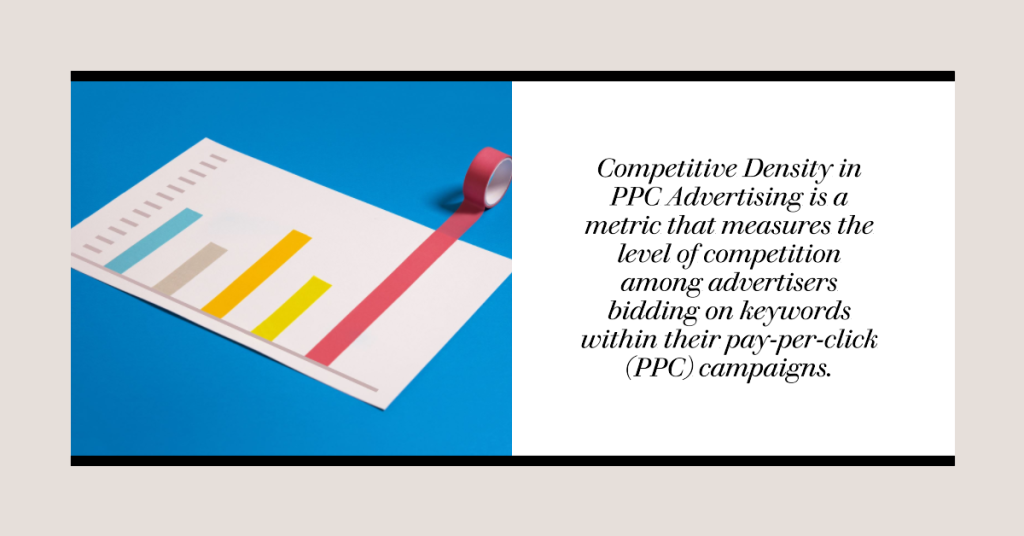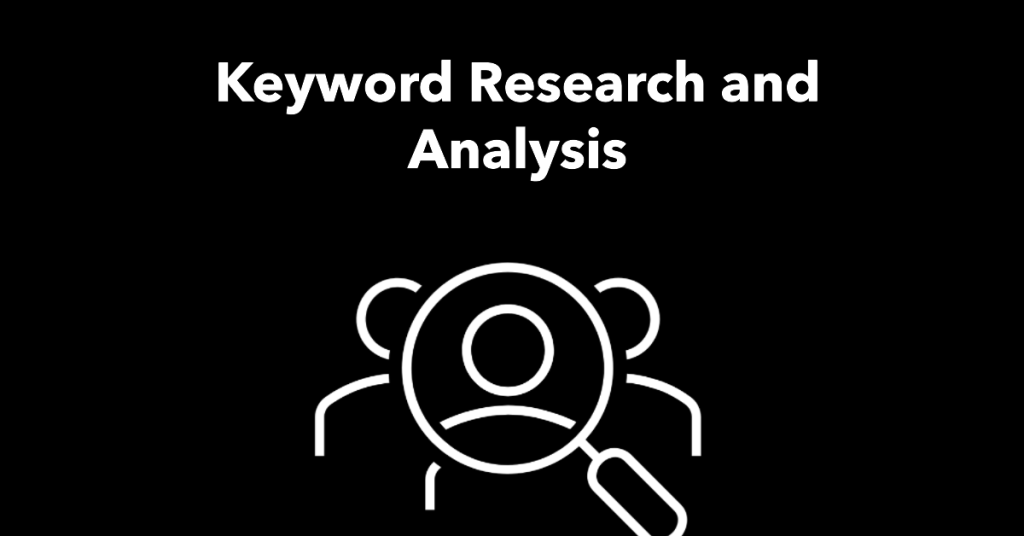Are you ready to unlock the secrets of keyword competition in PPC advertising? Picture this: you’ve poured your heart and soul into crafting a stellar PPC campaign, carefully selecting keywords that you believe will attract your ideal audience. But here’s the catch – the competition is fierce, and standing out from the crowd feels like an uphill battle.
That’s where understanding Competitive Density in PPC Advertising becomes crucial. It’s the key that unlocks the door to success in the highly competitive world of online advertising. By grasping the concept of Competitive Density and its impact on your campaigns, you gain the power to strategically position your brand and capture the attention of potential customers.
In this blog post, I’ll be your guide as we dive deep into the realm of Competitive Density in PPC Advertising. Together, we’ll unravel its intricacies and explore effective strategies to master keyword competition. Whether you’re an experienced digital marketer looking to refine your PPC techniques or a business owner seeking to make waves in the online advertising arena, I’ve got you covered.
Throughout our journey, we’ll demystify Competitive Density, and uncover proven techniques for conducting keyword research, competitor analysis, and campaign optimization. You’ll gain invaluable insights that will empower you to elevate your keyword competition skills and maximize the impact of your PPC campaigns.
So, get ready to conquer the challenges of keyword competition and seize the opportunities that lie ahead. Together, we’ll navigate the dynamic landscape of Competitive Density in PPC Advertising, propelling your campaigns to new heights.
Table of Contents
Understanding Competitive Density
Competitive Density in PPC Advertising plays a pivotal role in determining the level of competition advertisers face when bidding on keywords. It serves as a powerful indicator of the intensity and challenges involved in achieving a desirable ranking for specific keywords in the online advertising landscape.
In simple terms, Competitive Density refers to the degree of competition among advertisers vying for the same keywords within their PPC campaigns. It is measured on a scale from 0 to 1.00, with higher values indicating a higher level of difficulty to rank for those keywords.
By comprehending Competitive Density, advertisers gain critical insights into the competitiveness of their chosen keywords and can make more informed decisions about their PPC campaigns. Let’s explore a few key aspects related to Competitive Density:
Definition and Significance

Competitive Density in PPC Advertising is a metric that measures the level of competition among advertisers bidding on keywords within their pay-per-click (PPC) campaigns. It provides valuable insights into the intensity of competition for specific keywords in the online advertising landscape.
To put it simply, Competitive Density gauges the degree of saturation in the market for a particular keyword. It is represented on a scale from 0 to 1.00, where a higher value indicates a higher level of difficulty in achieving a desirable ranking for that keyword.
Understanding Competitive Density is crucial for effective campaign planning and optimization. Let’s explore its significance:
- Strategic Keyword Selection
By considering Competitive Density, advertisers can make informed decisions when selecting keywords for their PPC campaigns.
A high Competitive Density score signifies intense competition, indicating that numerous advertisers are actively bidding on the same keywords. As a result, achieving top rankings for these keywords becomes more challenging.
On the other hand, keywords with low Competitive Density present opportunities for advertisers. They indicate less competition, making it relatively easier to achieve higher rankings and generate visibility and clicks. Incorporating keywords with lower Competitive Density into PPC campaigns can lead to better chances of success and maximize the return on investment.
- Effective Campaign Planning
Competitive Density plays a vital role in campaign planning. Advertisers can use this metric to identify the level of competition they are likely to encounter for specific keywords. This knowledge allows them to allocate resources strategically and plan campaigns accordingly.
For keywords with high Competitive Density, advertisers may need to adopt aggressive bidding strategies, craft compelling ad copy, and continuously optimize their campaigns to stand out from competitors.
On the other hand, keywords with low Competitive Density require less aggressive bidding, offering an opportunity to focus on improving ad relevance and enhancing user experience.
- Difficulty of Ranking for Keywords
Competitive Density directly impacts the difficulty of achieving desired rankings for keywords. Keywords with high Competitive Density make it harder to rank among the top positions due to intense competition.
Advertisers need to be prepared for a more competitive landscape and adapt their strategies accordingly to gain visibility and attract clicks.
Alternatively, keywords with low Competitive Density indicate a less competitive environment, making it relatively easier to achieve higher rankings. Advertisers can seize these opportunities to gain an advantage and establish a strong presence within their target market.
In summary, Competitive Density in PPC Advertising is a valuable metric that measures the level of competition for keywords. Understanding Competitive Density allows advertisers to make strategic decisions regarding keyword selection, campaign planning, and optimization.
By factoring in Competitive Density, advertisers can navigate the landscape of keyword competition more effectively and achieve better results in their PPC campaigns.
Measuring Competitive Density
Competitive Density in PPC Advertising is a metric that helps measure the level of competition advertisers face when bidding on keywords in their pay-per-click (PPC) campaigns. It is represented on a scale ranging from 0 to 1.00. Understanding this scale is crucial as it provides valuable insights into the intensity of competition associated with specific keywords.
To help you better grasp the concept of Competitive Density, let’s delve into different scenarios:
- Low Competitive Density:
Keywords with low Competitive Density (e.g., 0.10 or 0.20) indicate a less competitive environment. This means that there are relatively fewer advertisers actively bidding on these keywords. As a result, it becomes easier to achieve higher rankings and attract clicks without facing intense competition. Advertisers can take advantage of these opportunities by targeting niche or long-tail keywords, establishing a strong online presence, and gaining a competitive edge over their counterparts.
- Moderate Competitive Density:
Keywords with moderate Competitive Density (e.g., 0.50 or 0.60) suggest a moderate level of competition. In this case, there are several advertisers bidding on the same keywords, making it moderately challenging to achieve top rankings. Advertisers need to employ strategic optimization techniques to stand out from the competition. This includes refining the ad copy to enhance relevance, optimizing landing pages, and closely monitoring campaign performance. By doing so, advertisers can maximize their visibility and increase the chances of attracting clicks and conversions.
- High Competitive Density:
Keywords with high Competitive Density (e.g., 0.80 or 0.90) represent a highly competitive landscape. These keywords attract a significant number of advertisers who are actively bidding to secure top positions.
Achieving a favorable ranking for keywords with high Competitive Density becomes considerably challenging due to the intense competition. Advertisers must develop sophisticated strategies to differentiate themselves from competitors. This may involve aggressive bidding, meticulous campaign optimization, continuous monitoring of performance metrics, and exploring innovative approaches to gain a competitive advantage.
By measuring Competitive Density, advertisers gain valuable insights into the level of competition associated with specific keywords. This knowledge empowers them to make informed decisions during the keyword selection process and while planning their PPC campaigns.
Analyzing Competitive Density enables advertisers to strategically allocate their resources and optimize their campaigns effectively. By adapting their bidding strategies, refining ad creatives, and improving landing page experiences based on the level of competition, advertisers can increase their chances of success in the dynamic landscape of keyword Competition.
The Impact of Competitive Density on PPC Campaigns

Competitive Density in PPC Advertising has a profound influence on the success of PPC campaigns and the overall landscape of keyword competition. By understanding this impact, advertisers can make informed decisions and develop effective strategies to navigate the challenges and maximize their campaign’s potential.
1. Challenges of High Competitive Density
When diving into the world of PPC (Pay-Per-Click) advertising, a key consideration that often surfaces is Competitive Density. This is a vital metric that measures the competition level for a specific keyword in the PPC landscape. The higher the Competitive Density, the fiercer the competition, and this comes with its own set of challenges.
The first hurdle is the implication of targeting highly competitive keywords. In simple terms, the keywords with a high Competitive Density are like popular restaurants in a big city – everyone wants to eat there. This translates to many businesses vying for the same keywords, leading to a ‘bid war’.
In this context, the bid refers to the amount you’re willing to pay to have your ad displayed when someone searches for that specific keyword. When the Competitive Density is high, businesses often find themselves in a bidding contest, each trying to outbid the other to secure that coveted top spot in search results. That’s where partnering with a digital marketing agency can make all the difference. We have the tools, knowledge, and expertise to help you navigate this complex bidding landscape.
For instance, imagine two bakeries, ‘Sweet Treats’ and ‘Baker’s Delight’, both aiming to capture the keyword ‘best bakery in town’. Given the high Competitive Density of this keyword, both will have to continually outbid each other to win the prime ad position. This constant one-upmanship invariably leads to an increase in bid costs.
The rise in bid costs segues into the next challenge, which is the need for a higher ad budget. With increased competition, it’s like being in an auction where the highest bidder wins. In our example, if ‘Sweet Treats’ wants to consistently appear above ‘Baker’s Delight’ in the search results, they’ll need to allocate more budget to outbid their competitor. Here at Make Vision Clear, we can strategize and optimize your PPC campaigns, ensuring that your budget is allocated efficiently.
Furthermore, even with a high ad budget, there’s no guarantee of success. Remember, the competition for those top spots is fierce. Every business wants its ad to be the first thing a potential customer sees when they search for a particular keyword. But only one ad can hold the top position, leaving the rest to compete for the remaining, less visible spots. Don’t leave it to chance.
2. Opportunities with Low Competitive Density
On the other hand, keywords with low Competitive Density present opportunities for advertisers. These keywords indicate a less saturated market with fewer advertisers actively bidding on them.
As a result, it becomes easier to achieve higher rankings and attract clicks without facing intense competition. Advertisers can leverage these keywords to their advantage by focusing their efforts on targeted campaigns, optimizing their ad copy and landing pages, and potentially achieving a higher return on investment with lower bid costs.
Understanding the impact of Competitive Density helps advertisers shape their PPC strategies effectively:
- Keyword Selection: By considering Competitive Density, advertisers can identify keywords that align with their campaign goals. They can strike a balance by targeting keywords with a mix of high and low Competitive Density, optimizing their chances of success while managing their resources efficiently.
- Competitive Analysis: Analyzing Competitive Density allows advertisers to assess their competitors’ presence and activities for specific keywords. This insight helps advertisers understand the strategies adopted by competitors and adapt their own campaigns accordingly to gain a competitive edge.
- Optimization and Monitoring: Advertisers need to continuously optimize their campaigns based on the Competitive Density of targeted keywords. This includes refining ad copy, improving landing page relevance, and monitoring performance metrics. By staying proactive and adapting to the dynamic competition, advertisers can improve their rankings and maximize their campaign’s effectiveness.
In summary, Competitive Density in PPC Advertising significantly impacts the success of PPC campaigns and keyword competition. Advertisers who grasp the implications of Competitive Density can make informed decisions about keyword selection, optimize their campaigns strategically, and navigate the competitive landscape effectively. By understanding and responding to Competitive Density, advertisers can maximize their chances of achieving desirable rankings and driving successful PPC campaigns.
See also: Google Search Console Insights Changes to Google Analytics 4 May Impact Data Reports
Strategies to Understand and Master Competitive Density
Tackling Competitive Density is akin to mastering a strategic board game like chess. You must know the rules, understand your competition, and plan your moves with precision.
Similarly, in the digital arena of PPC Advertising, understanding and mastering Competitive Density requires a blend of strategic thinking and tactical execution. Here are some effective strategies that can help you in this endeavor.
1. Keyword Research and Analysis

The first step in mastering Competitive Density is understanding what keywords your competitors are targeting. This requires comprehensive keyword research. Using tools like Google Keyword Planner can provide valuable insights into the popularity of specific keywords and the competition surrounding them.
For instance, let’s say you run a vegan bakery. In doing your keyword research, you might discover that “Digital Marketing Agency” has a high Competitive Density, while “Digital Marketing Agency in India” has a much lower Competitive Density. This data can help inform your bidding strategy and your overall PPC campaign.
2. Leverage Long-Tail Keywords
Long-tail keywords – phrases that are highly specific to your product or service – often have lower Competitive Density. These keywords may have lower search volumes, but they also often have higher conversion rates as they typically attract users who are further along in the buying cycle.
For example, a keyword like “Digital Marketing Agency” may have a high Competitive Density, while a more specific long-tail keyword like “Digital Marketing Agency in India” is likely to have less competition, making it easier and more cost-effective to target.
3. Balance Your Keyword Portfolio
As we’ve discussed earlier, a successful PPC campaign should strike a balance between high and low Competitive Density keywords. Think of it as diversifying your investment portfolio – by spreading your investments (or in this case, keywords), you reduce the risk of relying too heavily on one source and increase your chances of better returns.
For instance, while highly Competitive Density keywords like “Digital Marketing Agency” may drive a large volume of traffic, they’ll also be more costly and competitive.
On the other hand, low Competitive Density keywords like “Digital Marketing Agency in India” might draw in less traffic, but they are likely to attract a more targeted audience and have a lower cost-per-click (CPC).
4. Competitor Analysis
In the battlefield of digital marketing, understanding your enemy – or in this case, your competitors – is half the battle won. Competitor analysis plays an instrumental role in mastering Competitive Density, allowing you to build more informed and effective PPC strategies. Read Digital Marketing Trends For 2023 By Industry Experts.
Let’s think of this process as a football game. Before a match, teams study their opponent’s strategy, understand their strengths and weaknesses, and plan their moves accordingly. Similarly, competitor analysis involves understanding your competitors’ bidding strategies, keyword selection, and ad positioning, which can provide valuable insights to guide your own PPC tactics.
Tools like SpyFu and Semrush can serve as your digital binoculars, enabling you to delve deep into your competitors’ PPC strategies. They provide comprehensive data about your competitors, like which keywords they are targeting, their ad copy, and their overall performance.
For example, let’s say you run an organic skincare brand. Using SpyFu, you could identify that a competing brand is targeting high Competitive Density keywords like “Digital Marketing.” However, they might be missing out on opportunities with long-tail, low Competitive Density keywords like “Digital Marketing Agency in India.” Armed with this information, you can seize the opportunity to bid on these less competitive keywords, potentially gaining visibility and driving targeted traffic to your site at a lower cost.
By assessing their ad positioning, you can understand where their ads typically appear in search results. If they consistently rank high, it might suggest they have a significant ad budget and robust bidding strategy. This could influence your decision on whether to compete directly with these keywords or target alternative ones.
In a nutshell, competitor analysis is much more than just spying on your competitors. It’s a strategic move to understand the landscape of Competitive Density better, find untapped opportunities, and build a PPC campaign that stands out in the digital crowd. Remember, in the game of digital marketing, the more informed you are, the more likely you are to score the winning goal.
5. Leverage Negative Keywords
Using negative keywords is like setting up a filter for your PPC campaign. It ensures your ads don’t show up for irrelevant searches, which can save you money and increase your ad’s relevance. For instance, if you’re selling new books, including “used” as a negative keyword would prevent your ads from appearing in searches for used books, keeping your focus on your target audience.
In conclusion, understanding and mastering Competitive Density isn’t a one-time task—it’s an ongoing process that requires strategic planning, constant analysis, and a flexible approach. But with the right strategies, you can navigate the challenges of PPC advertising and drive your campaign towards success.
6. Campaign Optimization Techniques
Running a successful PPC campaign is like conducting a symphony – every element, from the bidding strategies to the ad copy, needs to harmonize to produce a beautiful result. This is where campaign optimization techniques come into play, fine-tuning your PPC efforts based on Competitive Density insights to achieve better results and maximize your ROI.
- Bid Management Techniques
Bid management is the beating heart of your PPC campaign. It’s like an auctioneer deciding how much to bid for a priceless artwork. Too low, and you might miss out; too high, and you might overspend. Effective bid management requires a careful balance, considering both your budget and the Competitive Density of your chosen keywords.
For instance, if you’re targeting high Competitive Density keywords, you may need to bid higher to secure a top ad position. However, it’s essential to continually monitor your keyword performance and adjust your bids accordingly to ensure they’re driving the desired results and not draining your budget. Automated bid management tools, like those offered by Google Ads, can be a big help in this regard, optimizing your bids in real time based on your campaign goals.
- Ad Copy Optimization
Creating compelling ad copy is like writing a captivating headline for a newspaper article. It’s what catches the reader’s eye and draws them in. Your ad copy should be engaging, and relevant, and include a clear call to action. Remember to incorporate your target keywords naturally, as this can improve your ad’s relevance and appeal to your audience.
For example, if you’re targeting the keyword “Digital Marketing Agency,” your ad copy could read, “Boost Your Business with a Top Digital Agency”
- Landing Page Relevance and Quality Score
Your landing page is where the user ends up after clicking your ad. It’s like the final destination of a journey, and it’s crucial that it meets the traveler’s expectations. A highly relevant, well-designed landing page can significantly boost your conversion rates. It should match the promise of your ad copy and provide a seamless, user-friendly experience.
Google also assigns a Quality Score to your ads, considering factors like your ad’s relevance, your landing page’s quality, and your historical Google Ads performance. A higher Quality Score can lead to lower costs and better ad positions, making it a key factor to optimize in your campaign.
In summary, optimizing your PPC campaign is an ongoing process that requires strategic thinking, constant monitoring, and regular adjustments. By understanding Competitive Density and implementing these optimization techniques, you can ensure your campaign hits all the right notes and delivers the performance you aim for.
See also: 25+ Best Digital Marketing Strategies for Online Education in 2023
7. Constant Monitoring and Optimization
Lastly, just as a skilled chef keeps a watchful eye on a simmering pot, continuous monitoring and optimization of your PPC campaigns are vital for mastering Competitive Density. This approach allows you to stay flexible and adapt your strategies based on performance metrics.
For example, if a high Competitive Density keyword isn’t delivering the expected return on investment (ROI), it might be more cost-effective to shift your focus toward low Competitive Density keywords that are performing well.
Reach out to Make Vision Clear today, and let us help you rise above the competition, one click at a time.
Making Informed Decisions

In the intricate dance of PPC advertising, Competitive Density is a rhythm you need to understand and move with. Making informed decisions based on this understanding can help you choreograph a more successful campaign.
Consider a basketball team planning their game strategy. The coach studies the other team’s strategy, identifies their strengths and weaknesses, and plans his moves accordingly.
Similarly, with insights into Competitive Density, you can strategically bid on keywords, optimize your ad copy, and fine-tune your landing page for improved results.
For instance, if you’ve discovered that a high Competitive Density keyword, like “SEO Agency,” is becoming too expensive and not yielding sufficient ROI, an informed decision might be to shift your focus towards lower Competitive Density keywords.
Long-tail keywords like “SEO Agency in India” might have less traffic, but the traffic they attract is likely to be more targeted and have a higher chance of converting.
Additionally, keeping a pulse on your competitors’ strategies can also help you make more strategic decisions. If you notice a competitor consistently outbidding you for a high Competitive Density keyword, instead of getting into a bidding war, you could choose to focus on other relevant keywords where there’s less competition. Tools like SpyFu and SimilarWeb can provide valuable insights into your competitors’ tactics.
On top of this, you can make data-driven decisions about your ad copy and landing page design based on user engagement metrics.
For example, if you notice that your ad copy isn’t generating the expected click-through rate (CTR), you might decide to revamp it to be more compelling and keyword-focused.
Lastly, understanding Competitive Density is not just about numbers; it’s about making informed decisions that align with your campaign goals and budget.
Continuous Monitoring and Evaluation
Imagine you’re steering a ship across the ocean. You wouldn’t just set your course and hope for the best – you’d continually check your compass and adjust your direction based on the winds and waves. The same applies to managing a PPC campaign.
Continuous monitoring and evaluation of your campaign performance and Competitive Density changes are vital to steer your PPC campaign in the right direction.
Analytics tools play an instrumental role in this process. They’re like your PPC compass, providing critical data on keyword performance, competition levels, and user behavior. Google Ads provides a host of metrics that can help you assess your campaign’s health, such as click-through rate (CTR), conversion rate, cost per click (CPC), and Quality Score.
Let’s take an example. Suppose you notice that a high Competitive Density keyword like “Digital Marketing” is driving a lot of clicks but few conversions. This could indicate that while the keyword is attracting traffic, it might not be the most relevant traffic. Based on this insight, you could decide to shift your focus towards a less competitive but more targeted keyword like “Digital Marketing Company in India.”
On the other hand, if a low Competitive Density keyword is delivering a high ROI, it might be worth increasing your bid for this keyword to drive even more traffic and conversions.
Remember that the landscape of digital marketing is ever-evolving, with search trends, user behavior, and competition levels constantly changing. Regular evaluation of your bidding strategies and making necessary adjustments based on observed trends is crucial to stay ahead in this dynamic environment.
See also: What Is SEO? An Introduction to Search Engine Optimization
Data-Driven Decision Making
Let’s talk about the importance of data-driven decision-making when it comes to managing Competitive Density in PPC advertising. It’s all about staying ahead of the competition, leveraging historical campaign data, experimenting with different approaches, and measuring the impact of changes can make all the difference.
Analyzing historical campaign data is where it all starts. Take a deep dive into the performance metrics like click-through rates, conversion rates, and cost per acquisition from your previous campaigns.
For example, let’s say you notice a decline in the click-through rate for a keyword like “Competitive Density”. Digging deeper, you might discover that increased competition for that keyword is affecting its visibility. Armed with this knowledge, you can adjust your bidding strategies and make smarter decisions to tackle the challenges posed by Competitive Density head-on.
Experimentation is key when it comes to managing Competitive Density. Don’t be afraid to try out different approaches! Play around with ad copy variations, landing page designs, and targeting options. Imagine you’re promoting a product in a highly competitive market.
A/B testing might reveal that using eye-catching visuals showcasing the unique features and benefits of your product generates higher click-through rates and conversions compared to generic descriptions. By continuously experimenting and refining your strategies based on data-driven insights, you can find the winning formula to combat Competitive Density effectively.
Now, let’s talk about measuring the impact of changes. This step is crucial to optimize your campaigns. Keep a close eye on key performance indicators (KPIs) like conversion rates, return on ad spend (ROAS), and cost per click (CPC). These metrics provide valuable insights into the success of your PPC campaigns. For instance, if changes made to your bidding strategies and targeting result in a higher conversion rate and a stable ROAS, you know you’re on the right track.
By staying vigilant and continuously monitoring these KPIs, you can make informed decisions to optimize your campaigns and achieve better results, even in the face of Competitive Density.
In a nutshell, data-driven decision-making is your secret weapon for managing Competitive Density in PPC advertising.
By analyzing historical campaign data, experimenting with different approaches, and keeping an eye on key performance indicators, you can stay ahead of the competition and achieve success in your PPC advertising efforts. So, embrace the power of data, get creative, and optimize your campaigns to overcome the challenges posed by Competitive Density.
Closing Thoughts
As we conclude our discussion on Competitive Density in PPC advertising, it becomes evident that understanding and managing keyword competition is paramount to achieving success. Let’s summarize the key strategies discussed and highlight their importance in your PPC campaigns.
Firstly, Competitive Density plays a vital role in determining the level of competition for specific keywords. By analyzing the performance metrics of your campaigns and keeping an eye on the competitive landscape, you gain valuable insights into the intensity of competition you’re up against. This knowledge allows you to make informed decisions when it comes to keyword bidding and ranking.
Throughout this article, we have emphasized the significance of data-driven decision-making. Analyzing historical campaign data helps you identify patterns and understand how competitive factors impact your campaigns. Experimenting with different approaches, such as ad copy variations or targeting options, allows you to find the strategies that resonate best with your audience in the face of Competitive Density.
Additionally, measuring the impact of changes through key performance indicators (KPIs) gives you tangible metrics to evaluate the success of your campaigns.
Let’s bring these strategies to life with an example. Imagine you’re running a PPC campaign for a digital marketing brand, targeting the keyword “digital marketing agency.” Analyzing historical campaign data reveals a high Competitive Density for this keyword, indicating fierce competition.
However, by experimenting with different ad copy variations and tracking the impact on KPIs like click-through rates and conversions, you discover that highlighting your brand’s unique design elements and offering exclusive discounts appeals to your target audience.
Armed with this knowledge, you can adapt your bidding strategy and optimize your campaigns to stand out among the competition.
Therefore, competitive density has a direct impact on keyword competition in PPC advertising. You can strategically navigate the competitive landscape if you master Competitive Density.
Remember to leverage data-driven decision-making, analyze historical campaign data, experiment with different approaches, and measure the impact of changes through KPIs. Stay adaptable to changing competition, continuously refine your strategies, and achieve better results in your keyword bidding and ranking efforts.
Apply these insights to your PPC campaigns, and witness the power of understanding and managing Competitive Density in driving your success.
Ready to take your PPC advertising to the next level? Let Make Vision Clear be your trusted partner in conquering Competitive Density and achieving exceptional results. Contact us today to optimize your campaigns, drive targeted traffic, and outshine the competition. Click here to schedule a consultation and elevate your PPC game!



